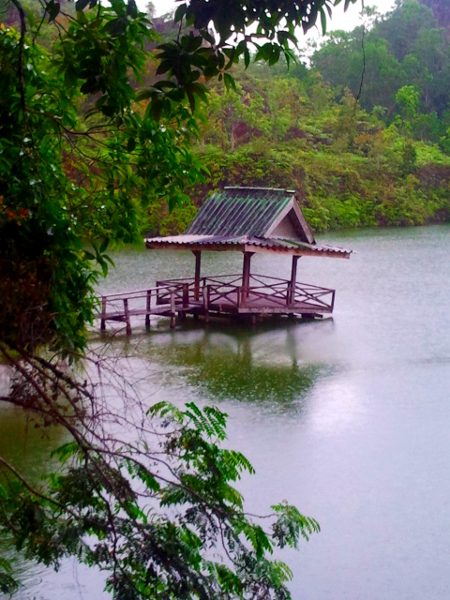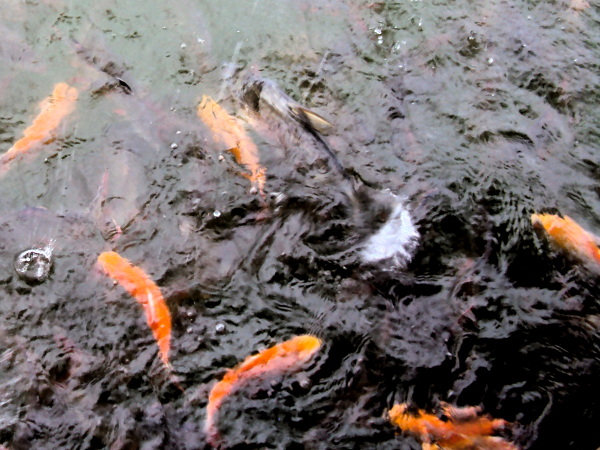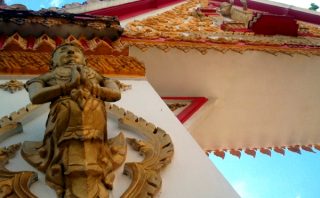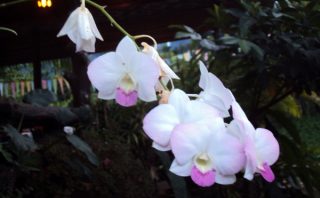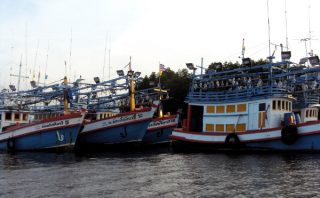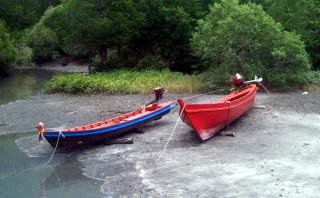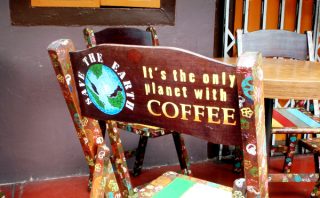We start our day packing up and watching young monkeys play in the neighbors laundry that they had hung up on the veranda to dry. They’ll have a surprise when they get back. After breakfast, we square up with Our Jungle Huts and they give us a ride up to the bus stop on Highway 401.
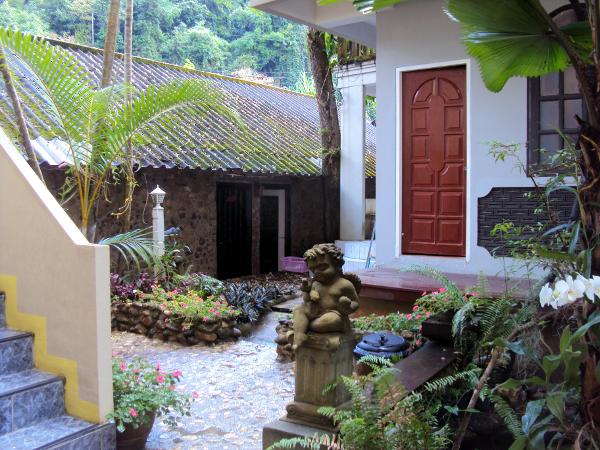
Today is a travel day. We are heading to Ranong, which is on the border with Burma (Myanmar) at the northern most point of the Thai Andaman Coast. The people in Ranong are diverse — Buddhist and Muslim Thai, Burmese, and Chinese. The port provides access to little Ko Chang, Ko Phayam, and Burma. A lot of travelers use Ranong for a visa run (leave Thailand, get passport stamped in Burma, come back to Thailand, renew Thai tourist visa).
We catch a bus heading west. Buses run about every hour on the half hour during the day. It’s well past when the bust should be here. We’re informed by the locals that the scheduled time can be up to plus thirty minutes. You don’t buy a ticket before hand or as you board the bus. You get a seat and after awhile someone comes along to collect your fare. They ask where you’re going and then tell you how much it is. We’re headed to Takuapa before heading north to Ranong. Takuapa is about 40 km (25 miles) away and we pay 100 baht each (about $3.30).
I settle into bus window “touristing.” We roll past some elephants that appear to be helping with some forestry. They’re hauling around logs in a small woodlot. We transfer at the Takuapabus station to one going towards Ranong. Several locals ask us where we’re going and guide us to the bus heading north.
Back to bus window “touristing” for the 188 kilometer ride. Takuapa and Khuraburi, the next large town we pass through, strike me as gray and busy places. I appreciate the bright colors in the lots selling spirit houses and the occasional Buddhist temple. They relieve the drabness of the gray towns and the monotony of the green jungle. I wonder about the dull concrete houses in the villages. These and the ones I saw in Khlong Sok seem dank and dark (except for the colorful floor tiling the Thai’s seem to prefer).
After the trip, I read up on traditional Thai homes (check out Thai Stilt Houses, Traditional Thai Style Houses, and Thai Houses). Like traditional houses throughout Southeast Asia, the Thai house is a wooden structure raised on posts. This offers protection from dirt, hostile wildlife, thieves, and the monsoon floods which affect all of Thailand and many other parts of Southeast Asia. Traditional Thai houses have acquired their own unique style that distinguishes them from the rest of the region including elegantly tapering rooves, filials, and decorations. Within Thailand, the architectural features also are unique in the different Thai cultural regions. Asian Historical Architecture writes:
The traditional Thai house is ideally adapted to its environment. The open high-pitched roof facilitates air circulation. Open windows and walls in combination with a large central terrace provide ideal ventilation and offer relief from the hot and humid climate. Wide overhanging eaves protect the house from sun and rain … The use of wood and bamboo reflects the once abundant forests that provided these materials ubiquitously and cheaply.
These homes sound a lot nicer than the concrete ones. I wonder what’s making people change? Cost of wood? Being sold on “progress and a modern house”?
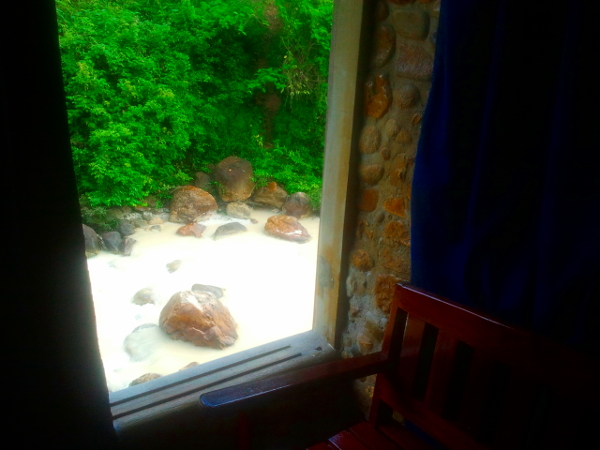
Ranong
We arrive in Ranong after about five hours of travel time for the day. A friendly lady working at the cafe next to the bus stop and tourist center calls our hotel for us. They will come and get us. We order late lunch of crab sandwiches and cokes while we wait.
Our ride arrives and after a short drive we check into Thansila Hot Springs Resort. Noi, the owner, suggests several things for us to do in the less than a day we have here. We think we’ll follow up on all of them except for going to the waterfalls and hotsprings in the nearby national park.
Thansila is much more than a bungalow resort and more than a bed and breakfast as well. I would call it a “boutique” hotel although I’ve never stayed in one. Maybe this is my first. The courtyard is charming and quirky. The floor in our room is polished concrete. And the walls are stuccoed with rounded river rock. We open the wooden shutters to a view of the river. The place has atmosphere, and air conditioning and hot water showers. Luxury.
We relax a bit in our room. Then we walk along the river towards the center of town. We pass by a busy outdoor market but keep going. The food smells good but we need to get to a pharmacy for some remedies for traveler ailments before all the shops close for the evening. The people working at the pharmacy don’t speak English and we don’t speak Thai, but we manage to get things communicated. After purchasing our remedies, we walk through a nearby outdoor market (not the same one that we walked by earlier). There are a lot of fish being cleaned and sold here even though the market is closing down for the day. I’m not exactly sure where we are and have no idea what the name of the market is.
We’re tired and don’t want to walk the 45 minutes back to the hotel so we wave down a saleng. These are a motorcycle taxi with a sort of sidecar for passengers. The driver provides us each with a helmet. Nice gesture but only an illusion of safety as we careen around the city streets grasping tightly to a bench mounted next to a motorocyle.

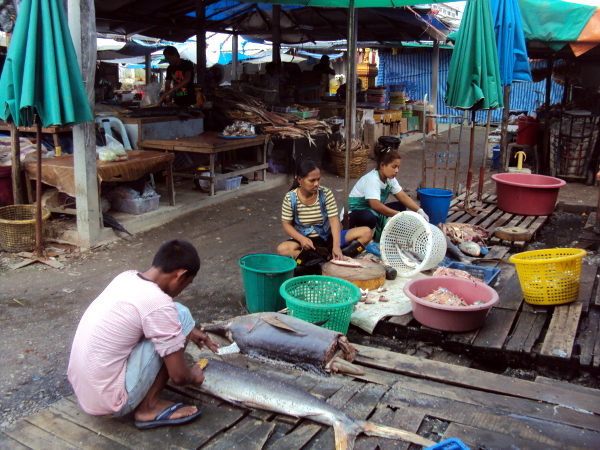
Rahsawarin Hot Springs
We eat dinner at Thansila. The waiter takes our order, serves us our drinks, then gets on a scooter and leaves. Well, at least I have a beer. Now that I’ve been in country a few days, I tend order Leo beer since it’s usually a little less expensive than the other two Thai beers, Chang and Singha. I also prefer its crisp, pilsener taste. The waiter returns with our meals. Apparently they aren’t cooking much in the kitchen here.
I have the fried chicken with the local curry. Lori has fried chicken with garlic. Both come with steamed rice and a fried egg on top. Mine has quite a bit of heat, as in sweat inducing, put the fire out with plain rice, order another beer, chili heat.
According to Noi, most folks go to the nearby hot springs in the cool of the evening. Cool is a relative thing. I don’t feel like it’s cooled off at all but an evening soak in the hot springs sounds nice anyway. Next to the hotel is a tree with a swing under branches decorated with lanterns. We sit in the swing a bit before walking the ten minutes to the hot springs.
At the springs, we walk past some public pools where people are soaking their feet but we don’t stop. We head to some hotel-managed soaking pools where 40 baht gets us a towel, changing room, and maintained pools. Some pools are hotter than others. All are relaxing. We try to chat with some locals. There are a lot of smiles and laughing.
On the walk back to the hotel, we are greeted in the narrow street by puppies. No, puppies, you can’t come home with us. Folks in the neighborhood are settling down for the evening. I try to respect their privacy and not look into their homes. But I notice. The houses have one or two rooms and there are many people in each setting up beds on the floor. There are ugly piles of trash on the side of the street. This is real poverty. What we call “poor” back in the US is “well off” in comparison. “Poor” Americans have a lot. Americans have way too much.
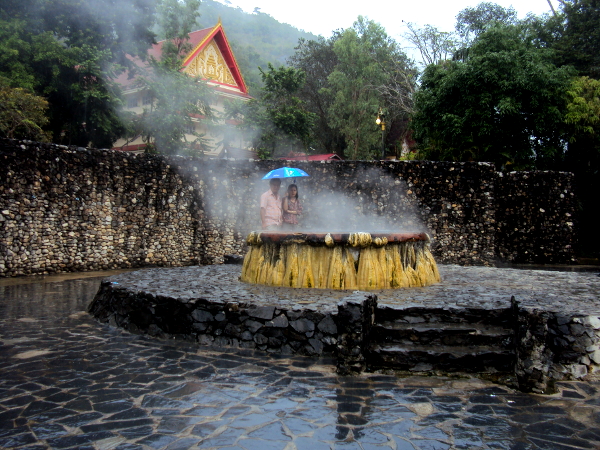
Ranong Canyon in the Rain
We have a little breakfast and make friends with the dog, Kanoon. Noi tells us kanoon means jackfruit. She says Kanoon is shaped and colored like her namesake.
We rent a scooter from the hotel and head out to find Ranong Canyon which is 9 km (about 5-1/2 miles) from town. We roll through some towns and then villages as we follow the tourist signs to the canyon. It starts to rain. We come to the end of the pavement. We figure we missed a sign or turn or something. It starts to rain harder. We shelter under what we think is a bus stop next to a park since the structures across the creek look like picnic shelters.
The rain lets up a little and we decide to head back. Maybe we’ll find Ranong Canyon on the return. We do. We had passed it. I thought that we were passing a pond, but it was the lake and canyon. The lake is a rain filled old mine or quarry. The canyon is made up of some slopes with exposed limestone. I wouldn’t really call them cliffs. Lake and canyon are stretching it. But it’s tranquil. We buy some fish food at a little shop and feed the fish in the rain. I wonder if anyone eats the fish. Some are big and there are a lot of them. I don’t think I’d swim here. There’d be too much bumping of my legs by fishy fins.
Time to head back if we’re going to catch the afternoon ferry for Christmas on an island. It’s raining hard. I get to be Lori’s wind and rain shield for most of it, but she still gets wet. We stop by the hot springs for some photos. The rain runs off of us in streams. Wet and cold and it isn’t fun on the scooter anymore. We go back to the hotel for hot showers and dry clothes. After a quick run to a gas station to fill up the moped and use an ATM, we have a quick lunch back at the hotel (we both order the same thing as the night before).
Noi has arranged a songthaew for us. The transport arrives and we’re off to the pier and Little Koh Chang.
